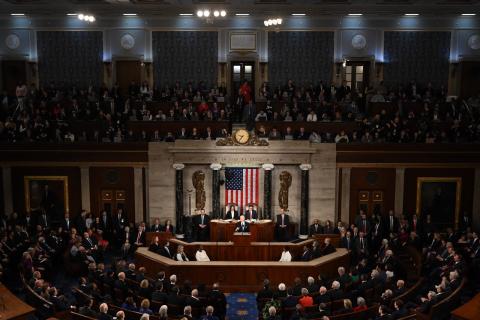Prime Minister Malcolm Turnbull announced major changes to the Australian Intelligence Community on 18 July. In the cauldron that typifies politics in Canberra, it was inevitable these changes would be interpreted by political commentators through the lens of political power plays within the Government. So we have been treated to countless stories about ministerial winners and losers, shoring up political alliances, dangerous concentrations of power, and accusations that the Government has not convincingly demonstrated the need for the creation of a new Department of Home Affairs.
In taking up the 'If it ain't broke, don't fix it' refrain, many commentators have ignored the essential thrust of the Government's announcement, which was more along the lines of 'It ain't broke, but that don't mean we can't make it better'.
Too often, governments are only stirred to improve national security or law enforcement capabilities after some catastrophic failure. Disaster-driven reform is the norm. In this tranche of intelligence reforms, the Government has sought proactively to make further improvements to an intelligence and law enforcement community, which it acknowledges was already working well, to ensure that this community is even better placed to address the range of threats the country faces now and will face in the future.
An increasingly important attribute of a successful intelligence community in our rapidly moving technological age is the ability to share systems, data and operational capabilities across the entire spectrum of agencies in a seamless, efficient and cost-effective manner. Inter-service rivalries, cultural differences and territorialism are the enemies of intelligence cooperation. Over the years, inter-agency cooperation has advanced in leaps and bounds, driven mainly by the exigencies of counter-terrorism. But there are always more benefits to be achieved through ever-increasing cooperation and rationalisation. The Turnbull intelligence reforms seek to reorganise the intelligence and law enforcement communities to achieve even greater operational effectiveness.
The Government has exercised its right to arrange portfolios in ways that it thinks best. It matters little to the effective operation of Australia's highly professional intelligence and law enforcement community whether they answer to an Attorney-General or a Minister for Home Affairs. We would expect them to perform equally well for both. What does matter in this totally inter-connected world is that the capabilities of our agencies are harnessed to provide even higher levels of protection for Australians and Australia's interests. For example, recognition of the integral role of the Australian Federal Police across all areas of security and closer alignment with the Australian Border Force are timely.
The real practical significance of the reforms lies not in the Turnbull Government's new portfolio arrangements but in its acceptance of the 23 major recommendations of the 2017 Independent Intelligence Review, conducted by Michael L'Estrange and Stephen Merchant. This comprehensive and incisive report seems almost to have been overlooked in the initial press coverage of the Prime Minister's announcement, yet it objectively identifies areas where a well-performing community can do even better.
The proposal to create a new Office of National Intelligence that combines the Government's existing strategic assessment capability (the Office of National Assessments) with a new function of management and coordination of the whole (and expanded) Australian Intelligence Community is a welcome step. The closest parallel to the new ONI would appear to be the US Directorate of National Intelligence, set up after 9/11.
The new Director-General of ONI, accountable to the Prime Minister but with statutory independence, would be the official Head of the Intelligence Community, with responsibility for advising on intelligence priorities, resource allocation, priority setting and evaluation of the intelligence community's efforts. D-G ONI should be a driver for unifying and-improving technological capabilities across the community as well as ensuring ever more effective data and capability sharing.
In recent years, the Australian Signals Directorate (ASD) has suffered serious staffing shortages as it tries to meet the increasing demands of both national intelligence and military intelligence requirements. Its Defence-based salary structure has seen it lose staff to the better paid private sector. The Government has accepted the recommendation that ASD become a statutory agency within the Defence portfolio – on a par with ASIO and ASIS. ASD is one of Australia's intelligence jewels, but it needs greater flexibility in the age of digital disruption. It needs geeks, not bureaucrats. At the same time, it must maintain its close working support for the operational arms of our defence establishment. Its new statutory status in the Defence portfolio should help achieve these goals.
The Australian Cyber Security Centre (ACSC) was set up to help protect government information and assist industry and ordinary Australians to defend themselves from cyber attack. As an inter-departmental consortium it has only slowly developed its role. A key need is to develop its outreach into the private sector. The new arrangements should ensure that the ACSC becomes a dynamic element of the Government's overall cyber security strategy – absolutely essential in this new age of cyber threats. The appointment of a Cyber Security 'Tsar' to manage the ACSC is long overdue.
The report covers a wide ground including the need for innovation and new intelligence tools and a rational, community-wide approach to their acquisition and joint use. It expands the Australian Intelligence Community from its original six members (ASIS, ASIO, the Australian Geospatial Organisation, ASD, ONA and DIO) to include the intelligence elements of the Department of Immigration and Border Protection, the Australian Federal Police, the Australian Border Force, the Australian Criminal Intelligence Commission, the Office of Transport Security and AUSTRAC. This brings the principal agencies that both produce and use intelligence together into a stronger cooperative relationship
The Government's announcement did not mention the fate of a number of security-related elements currently within the Attorney-General's Department. Logic suggests the Computer Emergency Response Team (CERT), Emergency Management Australia, the recently established Critical Infrastructure Centre, and the machinery for countering violent extremism could also be brought into the new Home Affairs structure
Some sections of the public will always be deeply suspicious of the secret intelligence function. These reforms, however, ought not to offend them.
In terms of oversight, the report recommends a wider role for the Parliamentary Joint Committee on Intelligence and Security and enhancement of the Inspector-General of Intelligence and Security. And in establishing the Home Affairs portfolio, the Government also announced it would strengthen accountability by bringing key oversight bodies - the IGIS, the Independent National Security Legislation Monitor and the Commonwealth Ombudsman - under the authority of the Attorney-General, the first law officer in the land.
Most importantly, civil libertarians should take heart that the new arrangements in no way weaken the 'ecosystem of safeguards' against illegality or impropriety by the necessarily secret intelligence agencies – a system originally devised by Justice Hope in the 1970s and which has been progressively strengthened since then.
There will be some quibbles as to the workability of some proposals (for example, the requirement for the Attorney-General to sign ASIO warrants). Some commentators will continue to debate the changes as political manoeuvring, rather than as carefully considered structural reforms designed to meet the demands of security and the safety of citizens into the third decade of the 21st century.
This is a Federal Government reform. A significant test will be the extent to which the new Home Affairs structure will lead to enhanced cooperation with State Government agencies, particularly State police forces. Federal-State cooperation is the key to countering terrorism and serious organised crime.
As a former intelligence agency head, I welcome the reforms. In the end, the ultimate issue will not be the politics of allocation of agencies to a new portfolio, but the increased effectiveness of the Australian Intelligence Community through the early implementation of these reforms.
One last thought. Organisational reforms do not change existing organisational cultures per se, and certainly not in a hurry. That takes leadership. Australia has the law enforcement and intelligence leaders to meet that challenge.

